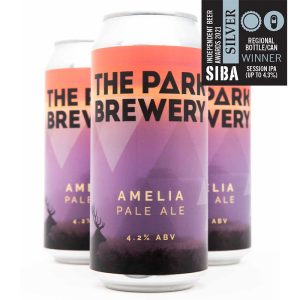Amelia, our best selling beer of 2021
Amelia is dry-hopped with Mosaic exclusively. It has a mix of tropical flavours, with aromas of sweet berries and summer fruits. A firm favourite among our customers, this beer is part of our core range and won Silver in the Session IPA category at the 2021 Small & Independent Brewers Association Beer Awards in the South East.
Buy cans online or visit the brewery to have a pint at the tap room.
Amelia is a beer that is steeped in history. Our drayman, Matt, has uncovered the full story behind the naming of the beer.
Amelia
Princess Amelia, 10th June 1711 – 31st October 1786, was the daughter of King George II and Queen Caroline. Amelia was born at Herrenhausen Palace, now in Lower Saxony, Germany. She was affectionately called Emily within her family. Amelia received music tuition from Handel, whom George II paid £200 p/a for the privilege. Amelia was one of eight children, and she outlived them all, even outliving the majority of her generation.
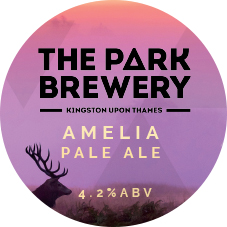
Amelia was always keen on riding, hunting and the outdoors. When she arrived in England following her father’s accession to the throne in 1727, Amelia was “a tomboy of seventeen and the hardest rider in the family, [she] spent much of her spare time in the stables, helping to feed and groom the horses.” Hunting was a favourite activity of the court of George I and George II, with Richmond Park being visited by the Royal Buckhounds no fewer than 13 times in 1732. Amelia clearly enjoyed getting stuck in to the hunt, as one account records that Amelia was thrown from her horse when a stag turned on her, and was dragged for some distance as her petticoat caught on the pommel. Aside from hunting, Amelia would have enjoyed playing cards and even gambling late into the evenings. Large quadrilles would have been set up, one for adults and one for young people, and Amelia would have played with the bedchamber ladies at lottery ticket, maybe winning or losing up to £100 in an evening. (Lady Pomfret was not best pleased…)
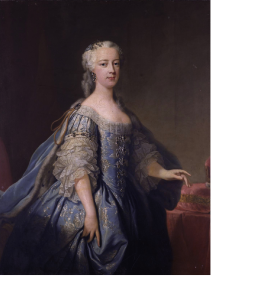
Portrait of Amelia by Jean-Baptiste van Loo c. 1738
Amelia was at one time betrothed to Prince Frederick of Prussia (later King Frederick the Great) but the marriage never materialised as Frederick’s mother wanted him to marry Elisabeth Christine of Brunswick-Wolfenbuttel-Bevern. Amelia received several marriage proposals from minor German princes but she rejected them all. Amelia is reputed to have had affairs with the Duke of Newcastle and the Lord Chamberlain, Duke of Grafton. The Duke of Newcastle and Amelia would often go hunting together, sometimes two or three times a week, and would ride away from the rest of the group. On one hunt at Windsor their attendants lost them altogether and they did not return to the castle until long after dark. Many assumed they took a private room for the night…
Amelia became increasingly eccentric in the court of her father George II, and was always happiest when hunting. She shocked fellow members of the congregation at the church in Hampton Court Palace by arriving in riding clothes, carrying a dog under each arm. Princess Amelia became prematurely deaf and peevish and, following the failed marriage with Frederick the Great, the marriage offers from the continent, and the affairs, she chose a life of spinsterhood. Her favourite pursuits at this time were horses, cards and gossip. Amelia could be insensitive to the feelings of others, especially her family, yet she developed a deep bond with her brother, the Duke of Cumberland. They would receive joint party invitations and lived together at St James’ Palace in the 1740’s.
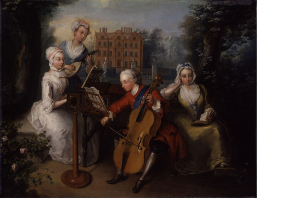
Amelia reading Milton pictured with her brother Frederick and sisters Anne and Caroline
Her family life was clearly chaotic, obviously exacerbated by the royal circles within which she existed. Amelia did not get along with her sisters, especially Princess Caroline and Anne, Princess Royal and Princess of Orange. Her mother and father, George II and Queen Caroline detested their son Frederick, the Prince of Wales as they were estranged for 14 years and Frederick became a young man who only really liked drink, gambling and women. When Amelia’s mother, Queen Caroline, was dying slowly from various serious ailments, including a strangulated bowel, George II forbade Frederick from seeing his mother.
Amelia – The Richmond Park Years
Amelia had a long association with Richmond Park before becoming ranger. Problems with access to the park pre-date her stint as ranger and issues with the royal hunting parties dominating the space persisted through the early 18th century. Robert Walpole, 1st Earl of Orford enjoyed hunting in Richmond Park and built himself Great Lodge (Old Lodge) to entertain hunting parties. His son, Robert Walpole, 2nd Earl of Orford was the King’s First Minister, now recognised as the first Prime Minister. Robert was also appointed Head Ranger in Richmond Park after the accession of George II in 1727. The Saturday closure of the House of Commons may date from this time, as Robert Walpole wanted to attend the Saturday meetings of the Royal Buckhounds in Richmond Park. Great crowds of people would meet to watch the royal hunting party in Richmond Park, causing such an issue for the royal family that on the 9th August 1735 a notice was released stating that no one would be admitted to the park to watch the hunt unless they had a ticket from the ranger.
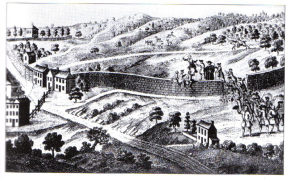
The parish council entering Richmond Park, Ascension Day 1751
Amelia was effectively the Head Ranger from 1749, however she was officially appointed to the position by her father, George II, in 1751. As a fan of hunting and riding, Amelia wanted Richmond for her own personal deer park. She began restricting access by only allowing pedestrians and carriages through the gates with a ticket, but only her friends received tickets.
As access to the park had been allowed to all since the enclosure in 1637, Amelia’s actions caused outrage. It was a regular custom on Ascension Day to “beat the parish boundaries” in which the extent of each parish was established for all to see. One such parish boundary lies in Richmond Park, towards the East Sheen Gate. 16th May 1751, Ascension Day, access was denied to the parish council by Amelia. She was asked by the vicar of Richmond, Thomas Wakefield, to place ladderstiles on the wall, but instead the parish council could only enter through a poorly maintained section of park wall that had crumbled. Amelia had even placed three or four men on the wall to deter entry.
An anonymous pamphlet, possibly attributable to a local brewer John Lewis, published in 1755 called Merlin’s Life and Prophecies. Most of the pamphlet concerns the prophecies of Merlin regarding British history and legend, however, it also includes a section about Princess Amelia and how she is prophesied to restore the ancient rights of the people regarding Richmond Park. Two court cases were brought to bear regarding the access issue to Richmond Park. The first was against Deborah Burges, a gatekeeper who had denied access at Coombe Gate, and was heard in 1754 at Croydon assizes. The court ruled in favour of Deborah Burges, and another anonymous pamphlet was published in 1755 criticising the decision and stating how Robert Walpole was to blame for the diminished access.
The issues regarding access to the park came to the forefront with the John Lewis debacle which occurred in 1757 at the East Sheen Gate. Waiting with a friend until a carriage approached the gate, John Lewis attempted to enter the park without a ticket. He was denied by the gatekeeper, Martha Gray, and thus brought on legal action. The case was finally heard at Kingston Assizes on 3rd April 1758. The court this time ruled in Lewis’ favour and the court issued that ladderstiles be placed next to East Sheen Gate and Ham Gate to allow pedestrian access to the park. The ladderstiles were opened to the public on 16th May 1758, but the ladder rungs were so spaced out that old people and children were unable to use them. They were eventually altered and pedestrian access to the park resumed once more.
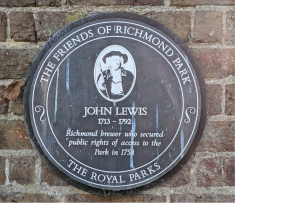
Blue plaque on East Sheen Gate commemorating John Lewis
John Lewis the brewer became a local hero. When his brewery on Petersham Road was destroyed by flooding, the vicar Thomas Wakefield organised a collection for his benefit and he was able to survive in near poverty until his death on 22nd October 1792. The unwanted bad press and subsequent unrestricted access for pedestrians into Richmond Park made it less attractive for Princess Amelia, and she gave up the position of ranger in 1761. The position was given to her nephew the new King George III.
Amelia: After Richmond
Amelia became owner of the Gunnersbury Estate in Middlesex in 1761 following her stint as ranger of Richmond Park and death of her father in 1760. She added a chapel to the house and at some point between 1777 and 1784 constructed a bath house which became known as “Princess Amelia’s bath house” (now a grade II listed monument). She also owned property in Cavendish Square, Soho where she spent the last few months of her life.
Amelia had a premonition that she and King Frederick the Great would both die in October, as had her father George II, and brother the Duke of Cumberland. Frederick died in August 1786, yet Amelia did in fact die on 31st October, the same year 1786, aged 75. She was found with a miniature of Frederick about her person when she died. She was buried in the Henry VII Lady Chapel at Westminster Abbey.
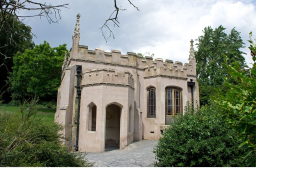
Princess Amelia’s bath house at Gunnersbury
Despite her royal upbringing and lifestyle it is hard not to feel sorry for Amelia. Her family life and personal circumstances would have left her with a lonely existence, turning to nature and riding as a means of escape. Richmond Park today provides the same escape for the many thousands of visitors it attracts each year. Amelia made the selfish decision to keep the park for herself, and it was only the dedication of the local community, championed by the brewer John Lewis, that ensured the park remained free for all. So raise a toast to John Lewis and the memory of Amelia, when tucking in to everyone’s favourite pale ale.
Further Reading
Baxter Brown, M. (1985), Richmond Park: The History of a Royal Deer Park, London.
Rabbitts, P. (2014), Richmond Park: From Medieval Pasture to Royal Park, Stroud.
The Hearsum Collection is based at Pembroke Lodge and contains a wealth of documents pertaining to every aspect of the history of Richmond Park.
The Friends of Richmond Park have produced invaluable blogs and pamphlets which provide detailed information about Richmond Park.

